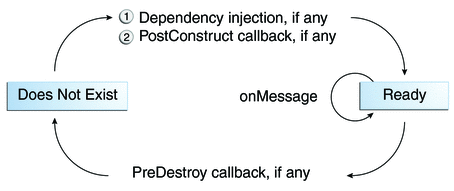Using Message-Driven Beans to Receive Messages Asynchronously
The sections What Is a Message-Driven Bean? and How Does the JMS API Work with the Java EE Platform? describe how the Java EE platform supports a special kind of enterprise bean, the message-driven bean, which allows Java EE applications to process JMS messages asynchronously. Session beans allow you to send messages and to receive them synchronously but not asynchronously.
A message-driven bean is a message listener that can reliably consume messages from a queue or a durable subscription. The messages can be sent by any Java EE component (from an application client, another enterprise bean, or a web component) or from an application or a system that does not use Java EE technology.
Like a message listener in an application client, a message-driven bean contains an onMessage method that is called automatically when a message arrives. Like a message listener, a message-driven bean class can implement helper methods invoked by the onMessage method to aid in message processing.
A message-driven bean, however, differs from an application client’s message listener in the following ways:
-
Certain setup tasks are performed by the EJB container.
-
The bean class uses the @MessageDriven annotation to specify properties for the bean or the connection factory, such as a destination type, a durable subscription, a message selector, or an acknowledgment mode. The examples in Chapter 31, Java Message Service Examples show how the JMS resource adapter works in the GlassFish Server.
The EJB container automatically performs several setup tasks that a stand-alone client has to do:
-
Creating a message consumer to receive the messages. Instead of creating a message consumer in your source code, you associate the message-driven bean with a destination and a connection factory at deployment time. If you want to specify a durable subscription or use a message selector, you do this at deployment time also.
-
Registering the message listener. You must not call setMessageListener.
-
Specifying a message acknowledgment mode. The default mode, AUTO_ACKNOWLEDGE, is used unless it is overriden by a property setting.
If JMS is integrated with the application server using a resource adapter, the JMS resource adapter handles these tasks for the EJB container.
Your message-driven bean class must implement the javax.jms.MessageListener interface and the onMessage method.
It may implement a @PostConstruct callback method to create a connection, and a @PreDestroy callback method to close the connection. Typically, it implements these methods if it produces messages or does synchronous receives from another destination.
The bean class commonly injects a MessageDrivenContext resource, which provides some additional methods that you can use for transaction management.
The main difference between a message-driven bean and a session bean is that a message-driven bean has no local or remote interface. Instead, it has only a bean class.
A message-driven bean is similar in some ways to a stateless session bean: Its instances are relatively short-lived and retain no state for a specific client. The instance variables of the message-driven bean instance can contain some state across the handling of client messages: for example, a JMS API connection, an open database connection, or an object reference to an enterprise bean object.
Like a stateless session bean, a message-driven bean can have many interchangeable instances running at the same time. The container can pool these instances to allow streams of messages to be processed concurrently. The container attempts to deliver messages in chronological order when it does not impair the concurrency of message processing, but no guarantees are made as to the exact order in which messages are delivered to the instances of the message-driven bean class. Because concurrency can affect the order in which messages are delivered, you should write your applications to handle messages that arrive out of sequence.
For example, your application could manage conversations by using application-level sequence numbers. An application-level conversation control mechanism with a persistent conversation state could cache later messages until earlier messages have been processed.
Another way to ensure order is to have each message or message group in a conversation require a confirmation message that the sender blocks on receipt of. This forces the responsibility for order back on the sender and more tightly couples senders to the progress of message-driven beans.
To create a new instance of a message-driven bean, the container does the following:
-
Instantiates the bean
-
Performs any required resource injection
-
Calls the @PostConstruct callback method, if it exists
To remove an instance of a message-driven bean, the container calls the @PreDestroy callback method.
Figure 30–9 shows the lifecycle of a message-driven bean.
Figure 30–9 Lifecycle of a Message-Driven Bean

- © 2010, Oracle Corporation and/or its affiliates
